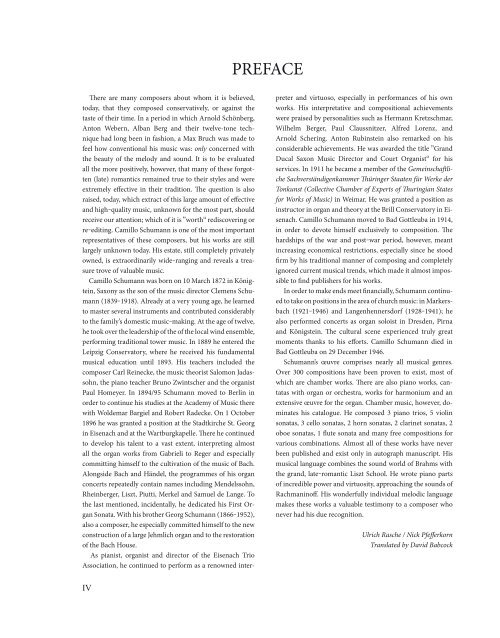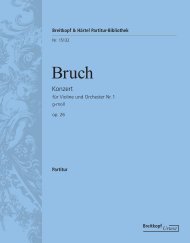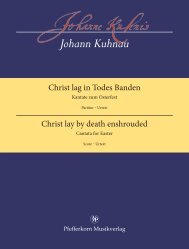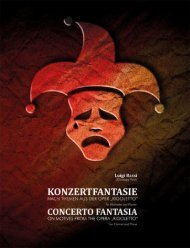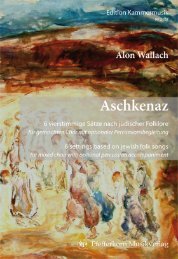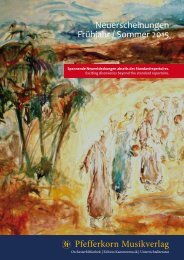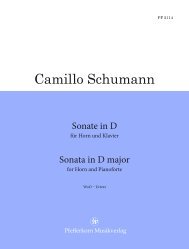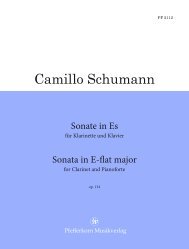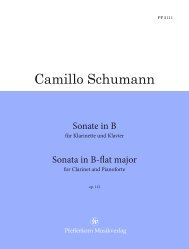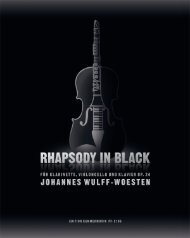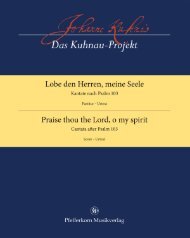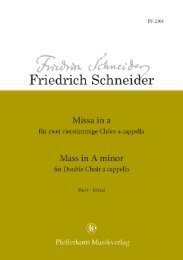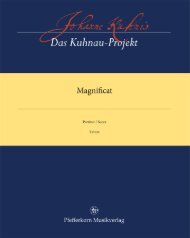PF-2113
Camillo Schumann Sonate Nr. 1 F-Dur für Horn und Klavier op. 118
Camillo Schumann Sonate Nr. 1 F-Dur für Horn und Klavier op. 118
Sie wollen auch ein ePaper? Erhöhen Sie die Reichweite Ihrer Titel.
YUMPU macht aus Druck-PDFs automatisch weboptimierte ePaper, die Google liebt.
PREFACE<br />
There are many composers about whom it is believed,<br />
today, that they composed conservatively, or against the<br />
taste of their time. In a period in which Arnold Schönberg,<br />
Anton Webern, Alban Berg and their twelve-tone technique<br />
had long been in fashion, a Max Bruch was made to<br />
feel how conventional his music was: only concerned with<br />
the beauty of the melody and sound. It is to be evaluated<br />
all the more positively, however, that many of these forgotten<br />
(late) romantics remained true to their styles and were<br />
extremely effective in their tradition. The question is also<br />
raised, today, which extract of this large amount of effective<br />
and high‒quality music, unknown for the most part, should<br />
receive our attention; which of it is ”worth“ rediscovering or<br />
re‒editing. Camillo Schumann is one of the most important<br />
representatives of these composers, but his works are still<br />
largely unknown today. His estate, still completely privately<br />
owned, is extraordinarily wide‒ranging and reveals a treasure<br />
trove of valuable music.<br />
Camillo Schumann was born on 10 March 1872 in Königtein,<br />
Saxony as the son of the music director Clemens Schumann<br />
(1839‒1918). Already at a very young age, he learned<br />
to master several instruments and contributed considerably<br />
to the family’s domestic music‒making. At the age of twelve,<br />
he took over the leadership of the of the local wind ensemble,<br />
performing traditional tower music. In 1889 he entered the<br />
Leipzig Conservatory, where he received his fundamental<br />
musical education until 1893. His teachers included the<br />
composer Carl Reinecke, the music theorist Salomon Jadassohn,<br />
the piano teacher Bruno Zwintscher and the organist<br />
Paul Homeyer. In 1894/95 Schumann moved to Berlin in<br />
order to continue his studies at the Academy of Music there<br />
with Woldemar Bargiel and Robert Radecke. On 1 October<br />
1896 he was granted a position at the Stadtkirche St. Georg<br />
in Eisenach and at the Wartburgkapelle. There he continued<br />
to develop his talent to a vast extent, interpreting almost<br />
all the organ works from Gabrieli to Reger and especially<br />
committing himself to the cultivation of the music of Bach.<br />
Alongside Bach and Händel, the programmes of his organ<br />
concerts repeatedly contain names including Mendelssohn,<br />
Rheinberger, Liszt, Piutti, Merkel and Samuel de Lange. To<br />
the last mentioned, incidentally, he dedicated his First Organ<br />
Sonata. With his brother Georg Schumann (1866‒1952),<br />
also a composer, he especially committed himself to the new<br />
construction of a large Jehmlich organ and to the restoration<br />
of the Bach House.<br />
As pianist, organist and director of the Eisenach Trio<br />
Association, he continued to perform as a renowned interpreter<br />
and virtuoso, especially in performances of his own<br />
works. His interpretative and compositional achievements<br />
were praised by personalities such as Hermann Kretzschmar,<br />
Wilhelm Berger, Paul Claussnitzer, Alfred Lorenz, and<br />
Arnold Schering. Anton Rubinstein also remarked on his<br />
considerable achievements. He was awarded the title ”Grand<br />
Ducal Saxon Music Director and Court Organist“ for his<br />
services. In 1911 he became a member of the Gemeinschaftliche<br />
Sachverständigenkammer Thüringer Staaten für Werke der<br />
Tonkunst (Collective Chamber of Experts of Thuringian States<br />
for Works of Music) in Weimar. He was granted a position as<br />
instructor in organ and theory at the Brill Conservatory in Eisenach.<br />
Camillo Schumann moved to Bad Gottleuba in 1914,<br />
in order to devote himself exclusively to composition. The<br />
hardships of the war and post‒war period, however, meant<br />
increasing economical restrictions, especially since he stood<br />
firm by his traditional manner of composing and completely<br />
ignored current musical trends, which made it almost impossible<br />
to find publishers for his works.<br />
In order to make ends meet financially, Schumann continued<br />
to take on positions in the area of church music: in Markersbach<br />
(1921‒1946) and Langenhennersdorf (1928‒1941); he<br />
also performed concerts as organ soloist in Dresden, Pirna<br />
and Königstein. The cultural scene experienced truly great<br />
moments thanks to his efforts. Camillo Schumann died in<br />
Bad Gottleuba on 29 December 1946.<br />
Schumann’s œuvre comprises nearly all musical genres.<br />
Over 300 compositions have been proven to exist, most of<br />
which are chamber works. There are also piano works, cantatas<br />
with organ or orchestra, works for harmonium and an<br />
extensive œuvre for the organ. Chamber music, however, dominates<br />
his catalogue. He composed 3 piano trios, 5 violin<br />
sonatas, 3 cello sonatas, 2 horn sonatas, 2 clarinet sonatas, 2<br />
oboe sonatas, 1 flute sonata and many free compositions for<br />
various combinations. Almost all of these works have never<br />
been published and exist only in autograph manuscript. His<br />
musical language combines the sound world of Brahms with<br />
the grand, late‒romantic Liszt School. He wrote piano parts<br />
of incredible power and virtuosity, approaching the sounds of<br />
Rachmaninoff. His wonderfully individual melodic language<br />
makes these works a valuable testimony to a composer who<br />
never had his due recognition.<br />
Ulrich Rasche / Nick Pfefferkorn<br />
Translated by David Babcock<br />
IV


